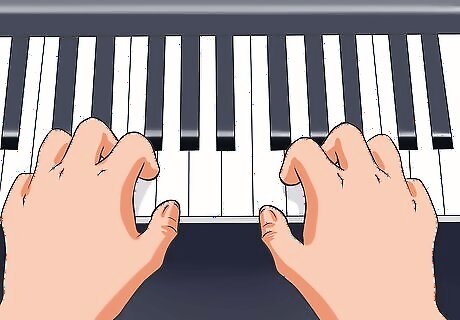
views
Analyzing a Piece of Music

Select a melodic song. A strong melody will be easier to learn to play by ear. Rock or folk songs usually have strong, easy to recognize melodies. Avoid songs with inconsistent melodies, such as rap and hip hop tracks.

Listen closely for patterns in the song. In music, notes combine in a specific way to make a scale or chord, and chords come together to form chord progressions. Chord progression patterns are especially common in popular music, so you should be able to recognize common patterns when you hear them. Recognizing chord progression patterns will help you to anticipate chord changes as you listen to a piece of music. For example, popular songs like ‘La Bamba’ and ‘Twist and Shout’ share one of the most common chord progressions of all time. If you can play the chords for one of these songs, you can easily play other songs with the same or similar chord progression.

Play the notes in the song one-by-one and observe how they sound. This will help you find the key of the song. To find the key of the song, you must first find the tonic or the root note, which is the first and last note in the scale of the song. For example, in the key of C Major, the tonic is C. The notes in a scale or key are like a family, so they are related and center around the tonic of the key. The tonic or the root note of the song will be the tone that sounds the most ‘at home’ in the song. It will sound like it could fit just about anywhere in the song.

Determine the melody of the song. Now that you’ve found the key of the song, try to find the melody based on the notes in the key. For example, in the key of C, the notes are C,D,E,F,G,A,B,C, so the melody will fall within these notes.

Play a tone a fifth above the tonic to determine the chord progression of the song. In general, the notes of scales and chords are assigned specific numbers. So, the fifth is a fifth note of the scale. If we use ‘La Bamba’ as an example, it is in the key of C major. So, G is the fifth degree of C Major, as you go five degrees up from C Major, i.e. C,D,E,F,G, A,B,C. It’s best to play a fifth above the tonic as the fifth is always the second most stable tone in any key. This tone should also feel like it could belong in any part of the song, though not as strongly as the tonic.

Repeat this process for each chord change. Focus on finding the root note for each of the chords, and then determine the fifth. For example, the root of the next chord in ‘La Bamba’ is F. To determine the fifth of the F chord, count five degrees up from F and this gives us C, i.e. C, D,E,F,G,A,B,C. Continue the same process for the next chord. Focus on playing each chord in sequence along with a recording of the song. This will help you determine if you are playing the right chords. If a chord sounds off, go back and try to adjust it based on your ear.
Practicing by Ear

Sing a section of the melody. Though you may not have the most beautiful singing voice in the world, singing will help to improve your ear. Your voice forms an important line between your instrument and the music you hear in your mind. If you can sing the intervals and chords of the song accurately, you will have an easier time identifying and playing them by ear. If you aren’t used to singing out loud, record yourself as you play a note on your instrument and then try to match your voice to it. Slide up or down on the scale until you can locate the note with your singing voice. Continue to do this with several other notes. Try to match the pitch of the note in your mind before singing it out loud. Don’t worry about notes that are too low or too high for you to sing well. Test your ear training by playing a note and then trying to sing it correctly. String several notes or sections of the song together and then try to play and sing it at the same time as one consistent melody. EXPERT TIP Aaron Asghari Aaron Asghari Professional Guitarist & Instructor Aaron Asghari is a Professional Guitarist and the lead guitarist of The Ghost Next Door. He received his degree in Guitar Performance from the Guitar Institute of Technology program in Los Angeles. In addition to writing and performing with The Ghost Next Door, he founded Asghari Guitar Lessons, where he was the primary guitar instructor for many years. Aaron Asghari Aaron Asghari Professional Guitarist & Instructor Try these exercises from our expert: If you want to learn to play by ear, first you have to train your ear to hear when a note is in pitch. Try playing a note, then matching that pitch with your voice. You will also need to train your ear to recognize chord qualities and melodic intervals.

Use call and response training. You can do this exercise alone or with a teacher or peer. Your teacher or peer will play a section of the song. You can also record yourself playing a section of the song. You will then repeat the section of the song by listening to the person play or the recording of your playing. Your teacher will listen to your response and give you feedback to improve your playing. Keep doing call and response until you can play a section or sections of the song.

“Noodle” around on your instrument to improve your ear. Playing around or “noodling” on your instrument allows you to find sounds and patterns you like, especially when you’re just starting to learn how to play your instrument. This will allow you to build an alphabet of fingering sequences, which are the building blocks of musical phrases and melodies. After enough “noodling”, you may be able to link together several fingering sequences and locate a tone you want to play in a sequence. While most music teachers may disapprove of playing around on your instrument, it is a great way to become familiar with tones and chords by ear, which you can then also recognize in popular songs and try to learn based on what your ear recognizes.



















Comments
0 comment